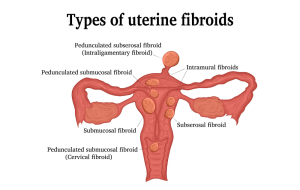What is a Pedunculated Fibroid?
Several terms are used to describe uterine fibroids or their location. It’s important to understand what these different terms mean, such as with the pedunculated fibroid. A pedunculated fibroid is a non-cancerous growth that attaches to the wall of the uterus. This type of fibroid can be found inside or outside the uterus and is named because of its growth shape.
A pedunculated fibroid is stalk-like in shape, making it different from other fibroids. It can be a submucosal fibroid or a subserosal fibroid, depending on where it is located.
You can speak with a fibroid specialist to learn more about treatment options if you have been diagnosed with pedunculated fibroids. Non-surgical treatment exists to help alleviate symptoms of fibroids that may interfere with your life.
Are Pedunculated Fibroids Dangerous?
Pedunculated fibroids aren’t any more dangerous than other types of fibroids. However, they can place pressure on nearby organs, cause significant discomfort, and disrupt your daily life. They can also impact fertility and pregnancy.
Comparing Fibroid Types: What’s Different About Pedunculated Fibroid?
Instead of growing in a round shape like other fibroids, they are thin, like stalks attaching to the uterine wall. Otherwise, they are similar to different types of fibroids and are attached to an artery, where they receive nutrients from the blood flow.

Pedunculated Fibroid Symptoms
Some women don’t experience any symptoms with pedunculated fibroids. In others, the symptoms are mild and may include:
If the fibroid rotates on its stem, it can cause a sharp pain because the movement restricts blood flow to the fibroid. You should discuss any symptoms you experience with your doctor.
Pedunculated Fibroid Causes
Just like with other fibroids, doctors don’t know what causes pedunculated fibroids. Certain factors do exist, which may lead to the development of fibroids.
- Hormones: Estrogen and progesterone seem to impact the growth of fibroids.
- Genetics: Fibroids often have different genetic compositions than normal uterine muscle cells.
- Extracellular matrix (ECM): ECM is the process that binds cells to each other and creates the dense tissue that make up fibroids.
- Other growth factors: Substances such as insulin-like growth can cause fibroids to grow.
Regardless of the causes of fibroids, they can all be treated.
Pedunculated Fibroid Treatment Options
A pedunculated fibroid can be treated like any other fibroid. A fibroid specialist will discuss the available treatment options for your fibroids to help you find relief. Both surgical and nonsurgical options exist for fibroid treatment.
Surgical options can include a hysterectomy or myomectomy. A hysterectomy results in the removal of the uterus while a myomectomy removes only the fibroids. However, both procedures can have serious side effects.
Uterine fibroid embolization (UFE) is a non-surgical treatment for fibroids, including pedunculated growths. A fibroid specialist inserts a tiny catheter into the leg and injects embolic material into the artery supplying the fibroid. This blocks the blood flow to the fibroid, causing it to shrink and die.
Are Pedunculated Fibroids Easy to Remove?
Pedunculated fibroids may be removed through Uterine Fibroid Embolization (UFE), a minimally-invasive, outpatient procedure with a shorter recovery time than surgery. This treatment is performed by a fibroid specialist who will insert a tiny catheter into an artery in the leg that feeds the fibroid. They inject embolic materials to block blood flow to the fibroid, causing it to shrink and die. Other options for treatment are surgeries, such as a hysterectomy or myomectomy. These invasive surgeries have longer recovery times and can cause serious or long-term side effects.
With a hysterectomy, you can no longer become pregnant or carry a child with a hysterectomy.. This procedure can be devastating for a woman who still wants children. Recovery time for a hysterectomy can be up to eight weeks.
A myomectomy can cause fertility complications even though it doesn’t remove any reproductive organs. It also may require a hospital stay of up to three days. While these procedures can treat fibroids, UFE is less invasive and has a shorter recovery time, allowing you to get back to your normal routines sooner.
Contact USA Fibroid Centers
If you have been diagnosed with a pedunculated fibroid, know that USA Fibroid Centers can help. Schedule a consultation online or call us for an appointment at one of our centers at 855-615-2555.
